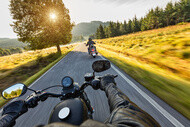
Tips and advice motorbike
Before setting off on a road trip with your motorcycle, there are a number of precautions to be taken, especially when it comes to loading. Discover our tips to avoid extra weight on your motorcycle for a safe ride.
Why is it important to avoid overloading your motorcycle?
The rear parts of the frame, made of steel or aluminium, do not respond well to excess weight on the luggage rack, in the top case or the side cases. In addition to the risk of twisting the rear loop, the handling is severely compromised. At high speeds, the steering can wobble and become a steering lock.
Checklist: eliminate what is not essential
Start by collecting all the things you think will be useful for your trip. Then consider what you really need.
Here are some tips for your sorting:
Travel bag
Once you have filled the left suitcase, the right suitcase and the top case, a large bag on the back will be excessive. If you put it on the top case, it will become a major overhang, which is not recommended. A small waterproof backpack that can be carried on your back and whose base can rest on the top case is preferable.
Camping equipment
If you are planning to take camping equipment with you, a pop-up tent will be too big and difficult to carry. A compact, lightweight tent that can be rolled up in its case is more appropriate.
Fuel cans
If you carry petrol in a can, choose a small, tightly sealed 3 litre can. It will be a reasonable weight on your motorcycle and will be enough to help you out.

Air pumps
Avoid large tyre or air mattress pumps. Prefer a foot pump with 2 pistons, more compact and useful for inflation needs. Protect it by storing it in a small dedicated bag.
Anti-theft device
Instead of a big chain, use a small lock that blocks the disc. It is efficient, small and light.
Tools
Choose a compact box that you can slip between two suitcases with a puncture kit and the levers to change the tyre. Carry a tool kit with the essentials. Don't bother with jumper cables, which can often be found on location.
Lamp
For lighting at night, prefer a headlamp or small lamp to a large torch.
Documents
You will need to protect your papers and documents from the rain. Choose a lightweight, waterproof pouch to hold your papers and documents.
Pharmacy
Take the essentials (especially what you can't buy on the road) and put them in a small kit.
Some light objects that can be very useful
Also consider these few lightweight items that may be of great use to you
- a small water filter, if you are far from everything, to filter the water and make it drinkable
- large American tape for repairs
- a roll of toilet paper
- a small mechanical pressure gauge
- a knife
- a compass
- a plaid

Take along Michelin maps of the area where you will be riding. Even if you use a GPS or your phone, you are not safe from a breakdown or a bug. In that case, you'll be glad you have the paper version to find your way back. They are also very useful to give you an overview of the region and perhaps the desire to discover other routes.
Keep a jumper or fleece accessible in your bag to wear in case of bad weather or a late return. As you get tired, you will feel the cold more intensely.
Always have a snack, a sweet, something sweet in your pocket in case you get tired. Take a break, have a drink and enjoy the energy provided by those few calories before heading out again.
Among the safety equipment, in addition to the reflective waistcoat, take a survival blanket to keep you warm or cool, depending on the situation, while you wait for help or the repairman.
Before you go, set up your motorcycle correctly
Once the motorcycle is loaded, it is advisable to fill up with fuel and invite the passenger to get on the saddle to make some adjustments.
Keep in mind that the bike should not be loaded beyond its maximum capacity (luggage + rider + passenger). Some types of motorcycles are overloaded quite quickly... Increase the preload of the front and rear suspensions (if possible). Then carefully test the reactions of your motorbike.
Next, consider adjusting the front headlight beam, which may be pointing at the stars. Finally, remember that once unloaded, the motorcycle must return to its proper suspension and optics settings.
Don't forget to check your tyre pressure according to the manufacturer's recommendations.
How to ride a loaded motorcycle
The handling of a motorcycle varies greatly depending on the total weight carried. Riding with passengers and luggage requires some precautions.
Anticipate as much as possible. Braking is directly affected by the load, which means you need to take more margin to compensate for the longer braking distance.
Beware of the handling, which is affected by the shift in the centre of gravity and the increase in the total weight of the motorcycle.
Suspension reactions can lead to steering effects such as wobbling, widening of the trajectory and a lack of precision. Similarly, the increased wind load can cause the vehicle to swerve, especially in gusty conditions.
Beware of wind and turbulence when overtaking trucks.
The lowered suspension reduces ground clearance. This can be surprising, especially in curves where the stand hits the road faster than usual. In city traffic, don't be trapped by the width of your suitcases when riding between two lanes.
The lack of acceleration makes it more difficult to overtake without a proper start.
Experience riding with the loads of the trip to master the new behaviour of your motorcycle.
Find the right tyre
Enter your vehicle or tyre size
We're searching for your tyre...
Wait few seconds we're processing your photo

Have your motorbike set up by a professional near you
Search by
Address, City or Post Code
Motorbike
Locate me
Top 5 cities in the UK



